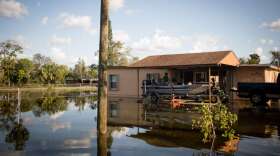-
As the Sunshine State continues to grow, its population is getting older. Sea level rise is also prompting people, especially young workers, to move inland while aging communities stay on the coast.
-
South Florida’s drainage canals are overwhelmed by king tides, and sea rise could only worsen the issue.
-
A Florida International University’s Martina Potlach, whose studies marry landscape design and ecology, gave ideas on how to reconceptualize how shorelines work if humans are to live in coastal South Florida as storms intensify and the sea moves in.
-
One million Florida properties are projected to be underwater. Today, those properties fund nearly 30% of local revenues for more than half the state's municipalities.
-
This week on The South Florida Roundup, we discussed new plans to protect Miami's coast from storms (1:00), the state taking control of Miami-Dade County's busiest local toll roads (19:00) and the Nicaragua's dictatorship outlawing the Jesuits (36:02).
-
The joint report from the University of Florida and 1000 Friends of Florida found a 23 percent increase in population and just under a foot of sea rise by 2040 could wipe out a million acres of undeveloped land.
-
The highest points in Miami-Dade County are unmarked and largely unnoticed. But high ground has played an outsized role in the history of South Florida’s development — and, more importantly, offers clues about how climate change could shape the region’s future. Starting with its real estate market.
-
Rising seas will shift tidal boundaries, leading to the loss of taxable properties, according to a new study. This is expected to impact the tax base of hundreds of U.S. coastal counties, with Florida being the state most affected.
-
As storm flooding worsens, federal report finds Florida has the most to lose along SE Atlantic coastThe 4-year study by the U.S. Army Corps of Engineers found storm surge flooding alone could amount to $24 billion annually with three feet of sea rise, thanks to a warming planet.
-
Managers are speeding up work on the aging pumps at the Broward-Miami-Dade county border and along the Little River to fight worsening flooding.
-
Environmental groups say as Gov. Ron DeSantis aims to strengthen infrastructure against sea level rise, he has failed to show much action on what is causing climate change and address the state’s reliance on fossil fuels.
-
Governor Ron DeSantis announced this week nearly $20 million in grant funding for Florida communities to better assess the risks to critical infrastructure posed by flooding from sea level rise, storm surge, and rainfall events.
Play Live Radio
Next Up:
0:00
0:00
Available On Air Stations











